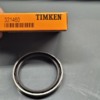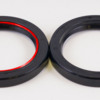The "sand seals" from Scat,etc. are cheap and not good quality. I replaced mine with SKF/CR double lipped seal which works much better, with "sand seal pulley" .
Sounds perfect. Got a part number?
It's not really the number of vents you have, but the size of them. That along with the health of the rings and valve guides can either make or break your "clean engine" mission. Your shift point matters too. If you never go above 4000-4500 rpm you won't have much problems. Go up to 6000-6500 and it's a different story.
I have AN-8 hoses on each valve cover. But my main breather comes from the distributor hole and is 3/4" I.D. and goes to a large tubular breather(75 cu. in.) with baffles, stainless steel wool, and drainback tube. That makes the difference for my application.
I couldn't agree with either of these posts more. I spin my engine higher than most anybody here. If a valvetrain and bottom end will hold together to 7000 RPM, I'm not shy at all about regularly winding out to 6500, which means that case pressurization is a problem to contend with.
The new engine will go in the car this winter, and I tried something I've never done before - valve stem seals. The heat generally destroys the Mexican OEM style, but I sourced some aftermarket 911 seals that we made work (the guide perches needed cut. They fit under the valve-springs because we're running single beehives. I used Deeves rings, which have a reputation for being on the softer end of the spectrum, and a Total-Seal second. We'll see.
Regarding breathers - I fabbed up a breather tank that has 2-1/2 gallons of capacity, and have a 1" hose (3/4 I/D) running from my CB breather tower. I've got a 3/4 hose on the top of the box running down to a Moroso check-valve vent, which uses the vacuum generated at by the Bernoulli effect to suck off the top of the ginormous box. It works great until the "cackle" of overrun (poppity pop pop on trailing throttle) blows out the check valve, so I vent to atmosphere. I've got the vents on the valve cover, but currently just run them up above the level of the top of the engine, and have little filters on the ends of them.
To summarize - if you have a stock-stroke engine and only run to 5000 RPM, then the stock breather tower vented to the airfilters is probably adequate, assuming your rings are OK. If you have a stroker, and want to rev, more is more. How much you need really depends on more than a generalization can provide.
More is more.









